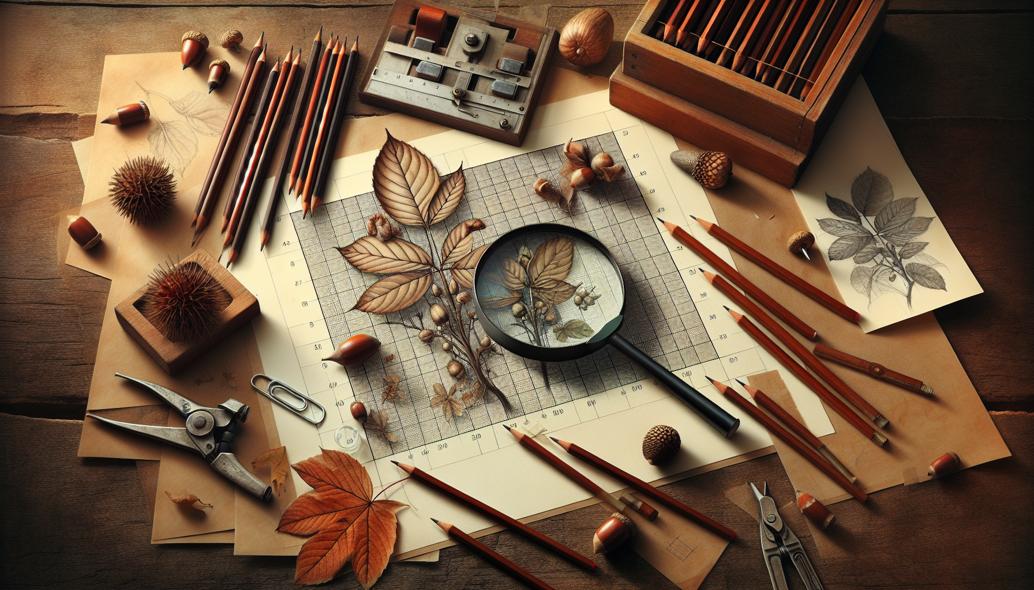Using the Grid Technique to Create Realistic Botanical Drawings
Unlock the secret to lifelike botanical art with the Grid method. Capture the intricate beauty and proportions of plants with precision, transforming your drawings into stunning realistic masterpieces. Discover how you can elevate your skills today!

Harnessing the Power of the Grid Technique for Realistic Botanical Drawings
When stepping into the intricate world of botanical drawing, one quickly realizes the importance of precision and detail. Capturing the nuanced beauty of plants is no easy task, especially when aiming for realism. One effective method that artists have used for centuries to achieve realistic representations is the Grid method. This technique is particularly beneficial when you desire to maintain accurate proportions in art, translating the essence of nature onto your canvas. In this post, we'll explore how you can leverage the Grid method to enhance your botanical drawing skills.
Understanding the Basics: What is the Grid Method?
The Grid method is essentially a drawing tool that helps artists scale images accurately using a grid system. This approach is excellent for breaking down complex subjects into manageable parts, ensuring that proportions remain consistent across your work. The technique involves overlaying a grid on both your reference image and your drawing surface, allowing you to transfer the image piece by piece, square by square. This not only aids in realism but also trains the eye to notice details that might be overlooked otherwise.
For botanical artists, the Grid method is invaluable. Given the complex structures of various plants—ranging from the intricate vein patterns of leaves to the delicate transition of hues in petals—maintaining proportions can be challenging. The grid acts as a guide to accurately depict all parts of a plant, ensuring that each leaf, stem, and petal is in proportion to the others.
Why Realism Matters in Botanical Drawing
Realism is more than just a style; it's a testament to the artist's skill and attention to detail. In botanical drawing, realism serves a functional purpose. Whether the artwork is used for scientific illustrations, educational resources, or simply for aesthetic enjoyment, capturing the true likeness of a plant is of utmost importance. The Grid method, with its focus on precision and detail, aligns perfectly with the goals of realism by methodically ensuring that each element is accurately represented.
Tools and Materials for Using the Grid Method
To effectively use the Grid method for your botanical drawings, you'll need a few essential tools and materials:
- Reference Image: Choose a high-quality photograph of a plant that you aim to replicate. The image should have clear details to ensure accurate rendering.
- Grid Overlay: You can create a grid using computer software by overlaying a grid onto your reference image or draw it on a printout using a ruler.
- Drawing Surface: Select a quality drawing paper suited for the medium you'll use, whether it's pencil, watercolor, or colored pencils.
- Drawing Tools: Depending on your preference and expertise, choose your tools. Common choices include graphite pencils, fine liners, or colored pencils.
- Ruler: A ruler is crucial for accurately drawing the grid on your paper.
Step-by-Step Guide to Applying the Grid Method
Step 1: Prepare Your Reference Image
Start by selecting the plant subject you wish to draw. Ensure the image is sharp and of high resolution. Once chosen, overlay a grid on the image using software or by hand. The size of the grid squares depends on the complexity of the plant and your preferred level of detail. Ensure every square is evenly spaced for accuracy.

Step 2: Draw the Grid on Your Paper
With a ruler and light pencil, replicate the grid from your reference image onto your drawing paper. The size of your drawing grid should be proportional to your reference grid, which can be the same size or scaled up, depending on how large you'd like your drawing to be. Maintain light lines to ensure they can be easily erased after completing your drawing.
Step 3: Begin Your Botanical Drawing
Now, focus on drawing one grid square at a time. Start from the top left, working methodically across the page. Within each square, carefully draw what you see in the corresponding square of your reference image, paying close attention to intersections, lines, and curves. This segmented approach makes managing the complexities of botanical structures significantly easier.
Step 4: Refine and Add Details
Once your entire subject is outlined, remove the grid lines on your drawing using a kneaded eraser. Then, focus on adding details such as shading, texture, and color. Botanical drawing often requires a variety of shading techniques to bring depth and realism to the piece. Techniques like hatching, cross-hatching, stippling, and blending are particularly effective.
Step 5: Evaluate and Enhance Your Work
Take a step back and evaluate your drawing as a whole. Ensure that all parts are proportionally accurate and connected harmoniously. Make any necessary adjustments to proportions and detailing. Adding highlights or adjusting tones can significantly enhance the realism of your work.
Tips for Success with the Grid Method in Botanical Drawing
- Practice Patience and Precision: This method requires time and careful observation. Don’t rush the process; instead, focus on accurately translating each section of your plant.
- Consistency is Key: Ensure that the grid on your paper exactly matches the reference grid in terms of proportion. Any slight deviation can impact the overall drawing.
- Enhance Observation Skills: Use the Grid method as an exercise to hone your observation skills, which is vital in all forms of drawing and sketching.
- Experiment with Grid Sizes: Larger grids are beneficial for detailed work, whereas smaller grids can help when focusing on large sections of the drawing.
Embracing the Art of Botanical Drawing Through Precision
Utilizing the Grid method in botanical drawing not only enhances your ability to create realistic artwork but also builds technical skills that transcend artistry alone. By embracing this methodical approach, artists can tap into the delicate intricacies of nature, achieving a balance of proportion, realism, and beauty. Whether you are a novice eager to learn or an experienced artist refining your craft, the Grid method remains an enduring technique of choice in the realm of nature drawing, providing a reliable foundation for creating botanical masterpieces.
